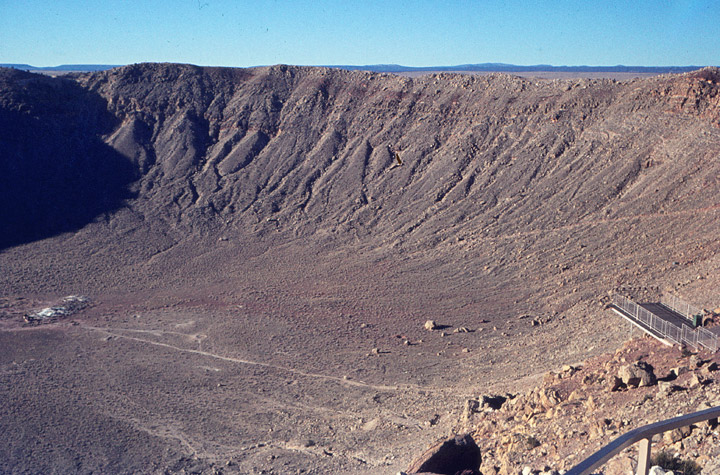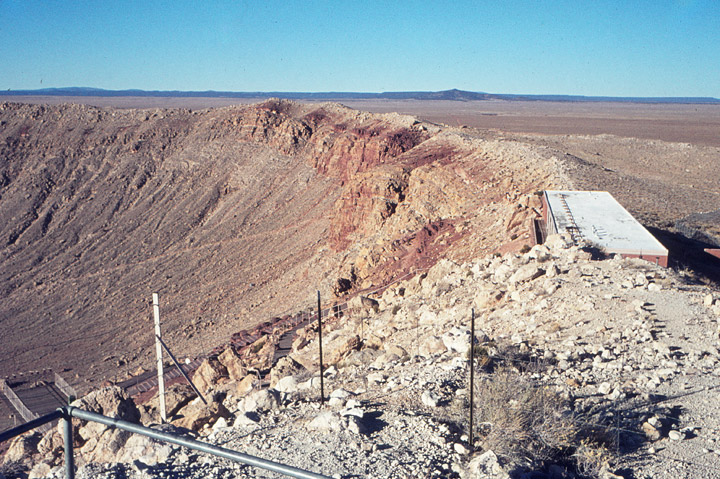

Meteor Crater

Meteor Crater
Meteor Crater is a meteorite impact
crater located about 35 miles (55 km) east of Flagstaff, near Winslow in the
northern Arizona desert of the United States. The site was formerly known as the
Canyon Diablo Crater, and scientists generally refer to it as Barringer Crater
in honor of Daniel Barringer who was first to suggest that it was produced by
meteorite impact.
Meteor Crater lies at an elevation of about 1740 m (5709 ft) above sea level. It
is about 1,200 m (4,000 ft) in diameter, some 170 m deep (570 ft), and is
surrounded by a rim that rises 45 m (150 ft) above the surrounding plains. The
center of the crater is filled with 210-240 m (700-800 ft) of rubble lying above
crater bedrock.
The crater was created about 50,000 years ago during the Pleistocene epoch when
the local climate on the Colorado Plateau was much cooler and damper. At the
time, the area was an open grassland dotted with woodlands inhabited by woolly
mammoths, giant ground sloths, and camels; it was probably not inhabited by
humans.

The object that excavated the crater was a nickel-iron meteorite about 50 meters
(54 yards) across, which impacted the plain at a speed of several kilometers per
second. The speed of the impact has been a subject of some debate. Modeling
initially suggested that the meteorite struck at a speed of up to 20 kilometers
per second (45,000 mph), but more recent research suggests the impact was
substantially slower, at 12.8 kilometers per second (28,600 mph). It is believed
that about half of the impactor's 300,000 tonne (330,000 short tons) bulk was
vaporized during its descent, before it hit the ground.
The impact produced a massive explosion equivalent to at least 2.5 megatons of
TNT – equivalent to a large thermonuclear explosion and about 150 times the
yield of the atomic bombs used at Hiroshima and Nagasaki. The explosion dug out
175 million tons of rock. The shock of impact propagated as a hemispherical
shock wave that blasted the rock down and outward from the point of impact,
forming the crater. Much more impact energy, equivalent to an estimated 6.5
megatons, was released into the atmosphere and generated a devastating
above-ground shockwave.
For a meteorite of its size, the impact melted surprisingly little rock, though
it produced high enough temperatures and pressures to transform carbon minerals
into diamonds and lonsdaleite, a form of diamond found near the crater in
fragments of Arizona's Canyon Diablo meteorite. Limestone blocks as massive as
30 tons were tossed outside the crater's rim, and debris from the impact has
been found over an area of 100 square miles (260 km˛). The shock of the impact
would have produced a localized earthquake of magnitude 5.5 or higher.

The blast and thermal energy released by the impact would certainly have been
lethal to living creatures within a wide area. All life within a radius of three
to four kilometers would have been killed immediately. The impact produced a
fireball hot enough to cause severe flash burns at a range of up to 10 km (7
miles). A shock wave moving out at 2,000 km/h (1,200 mph) leveled everything
within a radius of 14-22 km (8.5-13.5 miles), dissipating to hurricane-force
winds that persisted to a radius of 40 km (25 miles).espite this destruction,
the Barringer impact did not throw up enough dust to seriously affect the
Earth's climate. The area was likely recolonized by the local flora and fauna
within a century. This did not much affect the crater itself; its preservation
was aided by the local climate's shift to its present-day arid conditions.
The meteorite itself was mostly vaporized. Relatively large chunks of
nickel-iron fragments, ranging from gravel size to blocks weighing up to 640 kg
(1,400 lb), have been recovered from the debris field surrounding the crater.
Several thousand tons of tiny nickel-iron droplets, the size of sand grains,
fell in and around the crater after condensing from the cloud of metallic vapor
produced by the impact. Very little of the meteorite remained within the pit
that it had excavated.
Text from Wikipedia